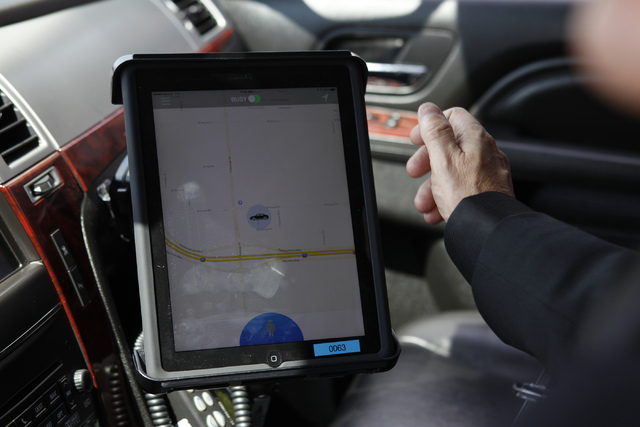Ride Genie, a more expensive Uber, comes to Las Vegas

It’s like Uber, only legal.
It’s a homegrown app that you can use to request a ride, just like Uber.
And, oh yeah, it’s more expensive than Uber to use.
The company that delivered the Ride Genie app to Southern Nevada’s limousine industry last year has geared up to roll out an upgrade that will enable customers to use the technology to hail a cab as well.
The Nevada Taxicab Authority in January approved the app’s use so it was only a matter of Integrity Vehicle Solutions, the Las Vegas company that developed the app, working out a few details before the official public launch.
Today, Integrity officials say the app is ready to roll. It’s going to be interesting to see how well it fares.
Those familiar with ride-hailing technology know the drill. Prospective customers with smartphones download the Ride Genie app from the Google Play or iTunes store for free.
Once the app is on your phone, you must register with a name, phone number, email address and credit card number. The process also includes an image capture of the front of your credit card. All your information is protected by password.
To request a taxi ride, you first have to log on to the app and select “taxi” as your mode of transportation (as opposed to a limousine, sedan, sport-utility vehicle or a vehicle specializing in transporting disabled customers).
Using a map of Southern Nevada, a customer uses electronic pinpointers to identify the customer pickup spot.
Once a customer presses the button to hail a ride, the magic starts on the taxi end. A universal dispatch desk selects the cab closest to the pickup point. The driver must accept the assignment quickly or it will be given to the next closest driver.
The single central dispatch facility is something new to the Clark County taxi industry. In the past, the 16 cab companies handled their own dispatches, and that led to breakdowns in communication that resulted in spotty service to the public.
A common scenario was that a residential customer would call for a taxi ride. The cab would be dispatched and the driver either couldn’t find the customer or the customer, thinking the cab wasn’t coming, called another company.
Sometimes, a customer would call multiple companies to request a ride to cover all bases, figuring that somebody eventually would respond. But what that did was irritate the few drivers responsible enough to respond to a call because, in many instances, the customer was considered a no-show. That’s one of the reasons the taxi industry cites residential service as being so poor — drivers backed away from picking up in neighborhoods because they felt, in many instances, they were wasting their time.
The centralized dispatch system and the app should change that.
With centralized dispatch, cabs should be able to get to residences faster. And, if there’s a no-show situation, the cab company still will collect a $10 fee if the customer cancels the ride three minutes or more after requesting it with the app. Remember, the company has your credit card number.
In addition to introducing the app, the taxi industry is now offering a single telephone number to reach the dispatch center. It’s 702-GET-TAXI (702-438-8294).
The industry made one other improvement in the system. It requested and got a new category of “medallions,” those plates on each cab that define where or when they can operate.
The vast majority of medallions can be used at any location around the clock. Others are restricted by time or by a geographic zone. The newest medallions authorized by the Taxicab Authority are geographically restricted to pickups outside the traditional tourism corridor along the Strip, in downtown Las Vegas and at McCarran International Airport. Taxi companies plan to stage cabs at neighborhood casinos on the valley’s periphery. For example, there might be some cabs staged at the M Resort to handle residential requests from Seven Hills, others at Red Rock Resort to accommodate residents of Summerlin and some at the Cannery that can dispatch quickly to North Las Vegas.
Several cab company executives I’ve talked with say they plan to pay drivers working the residential areas at a higher rate than those in the resort corridor to encourage drivers to be there. Not every company, however, has bought into that.
So how successful will the Ride Genie taxi app be? It’s hard to tell just yet.
Consumers have clamored for Uber in Southern Nevada because of its ease of use. Do they want Uber, or would a reasonable facsimile do?
But then, there are areas where Uber and Ride Genie are quite different from each other. One big one is the cost.
The Taxicab Authority approved a fee of up to $3 per ride on any app-generated trip. In previous regulations, the authority also allowed a fee of up to $3 on any credit card transaction for a cab ride. Since the app requires payment by credit card, the additional $3 fee is tacked on.
The Ride Genie app also calculates an automatic 20 percent tip to the driver as a default setting. The customer can increase or decrease that amount, but if you’re like me, you might forget about that until after you’ve pushed the button approving the transaction.
Integrity plans to begin a marketing campaign for Ride Genie in the weeks ahead, but whether it will catch on with Southern Nevada’s millions of tourists is another question.
Meanwhile, there still hasn’t been any significant movement toward Uber becoming a legal operator in Nevada. The company has at least 11 lobbyists working on that in Carson City during the current legislative session.
Uber has been reluctant to apply for licensure as a transportation provider, considering itself a technology company that works with independent contractors.
Questions and comments should be sent to roadwarrior@reviewjournal.com. Please include your phone number. Follow @RJroadwarrior on Twitter.